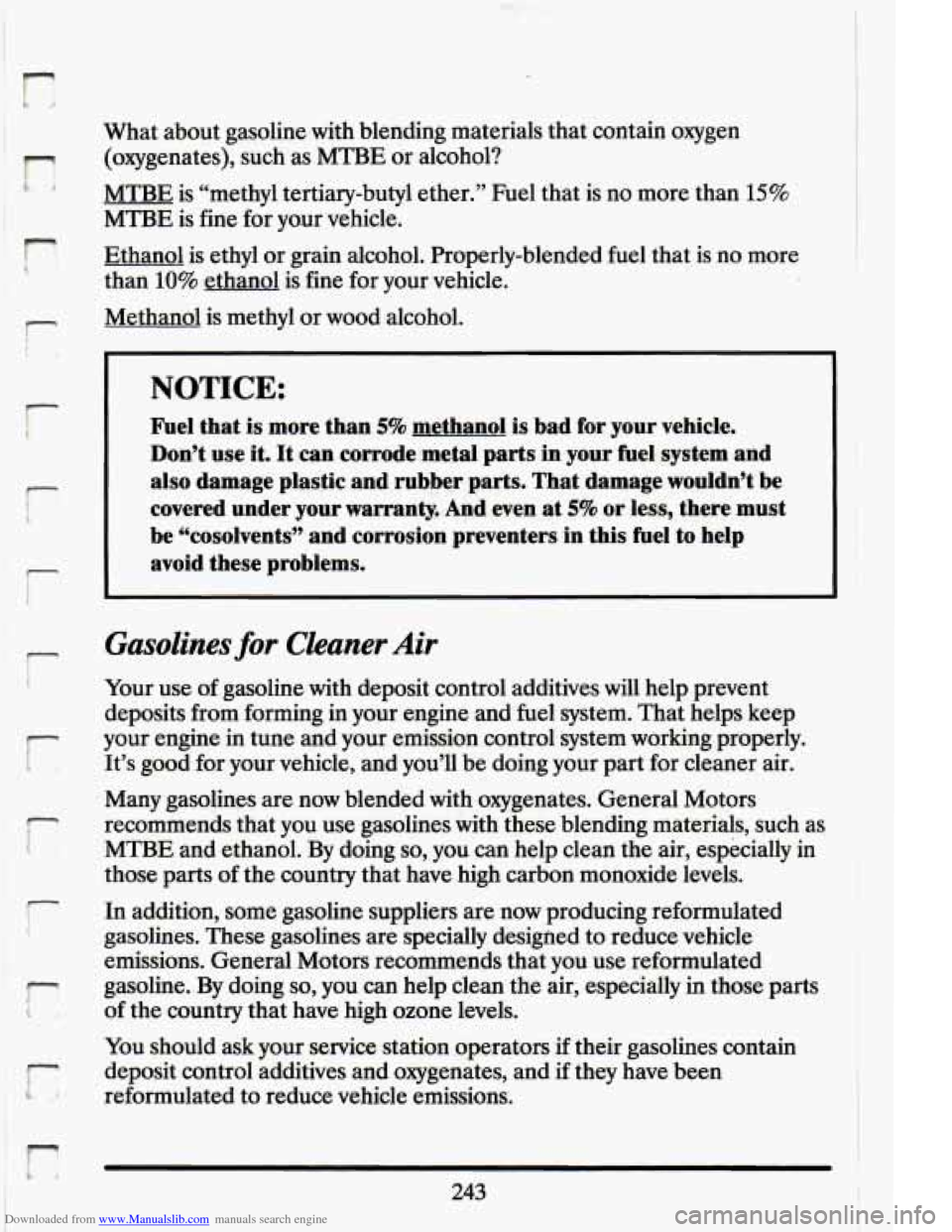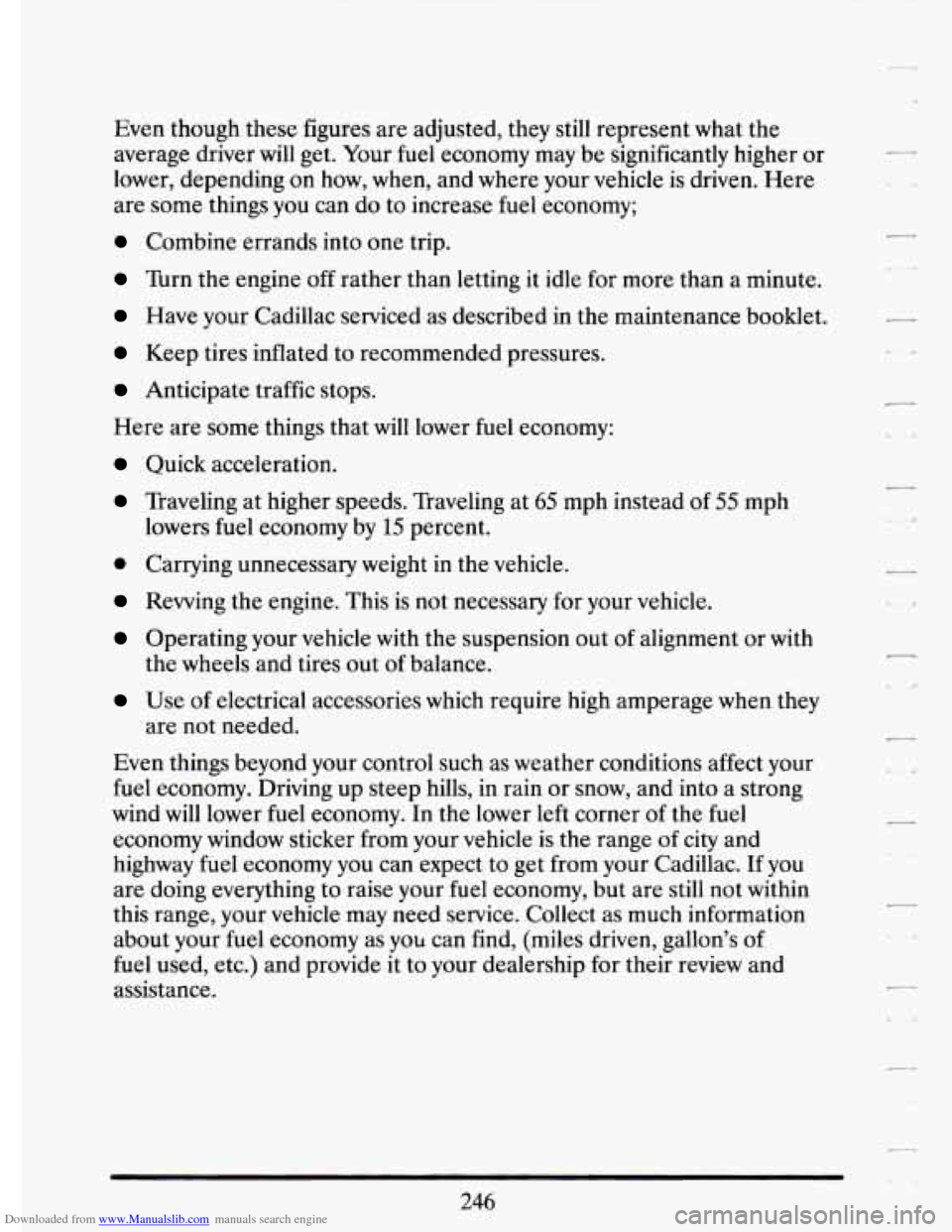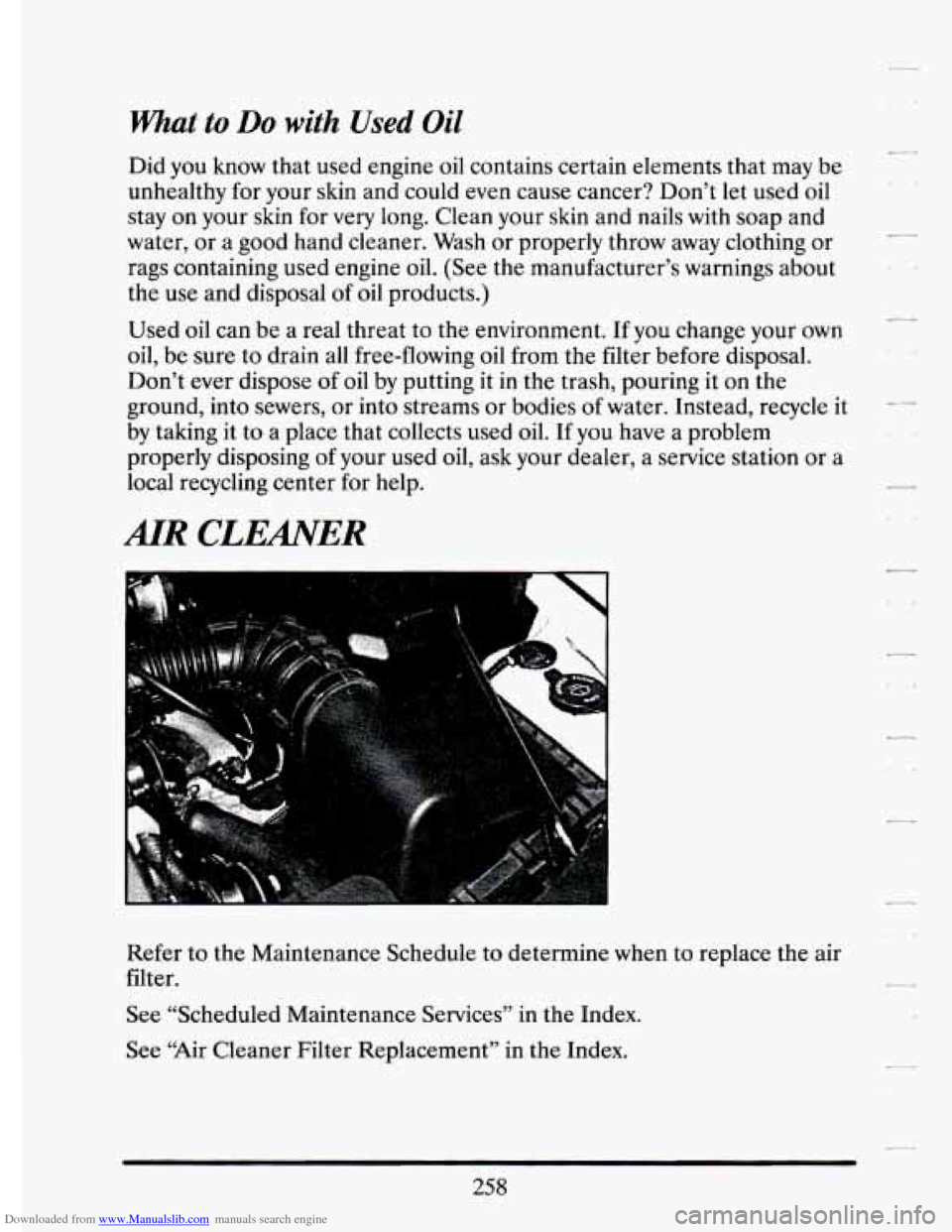Page 234 of 398
Downloaded from www.Manualslib.com manuals search engine 2. Turn on your heater to full hot at the highest fan speed and open the
window as necessary.
3. Dial temperature control to the highest heat setting and open the
window, as necessary.
If you no longer have the overheat warning, you can drive. Just to be safe,
drive slower for about ten minutes.
If the warning doesn't come back on,
you can drive normally.
If the warning continues, pull over, stop, and park your vehicle right\
away.
If there's still no sign of steam, you can idle the engine for two or three
minutes while you're parked, to see
if the warning stops. But then, if you
still have the warning, TURN
OFF THE ENGINE AND GET
EVERYONE
OUT OF THE VEHICLE until it cools down.
You may decide not to lift the hood but to get service help right away.
COOLING SYSTEM
When you decide it's safe to lift the hood, here's what you'll see:
A. Coolant surge tank with pressure cap
B. Electric engine fans
222
c-
--a
Page 236 of 398

Downloaded from www.Manualslib.com manuals search engine I NOTICE:
Engine damage from running your engine without coolant isn’t \
covered
by your warranty. See “Overheated Engine Protection
Operating Mode” in the Index.
If there seems to be no leak, check to see if the electric engine fans are
running. If the engine is overheating, both fans should be running.
If they
aren’t, your vehicle needs service.
How to Add‘Coolant to the Coolant Surge Tank
If you haven’t found a problem yet, but the coolant level isn’tvisible
inside the surge tank add a
50/50 mixture of clean water (preferably
distilled) and a proper antifreeze at the coolant surge tank, but be sure
the cooling system, including the coolant surge tank pressure cap, is
cool
before you do it. (See “Engine Coolant’’ in the Index for more
information about the proper coolant mix.)
If it isn’t, you may have a leak in the radiator hose, heater hoses, radiator,
water pump or somewhere else in the cooling system.
c
NOTICE:
I
In cold weather, water can freeze and crack the engine, radiat\
or, -
heater core and other parts. So use the recommended coolant. L
_I
224
Page 253 of 398

Downloaded from www.Manualslib.com manuals search engine r:
r
r
r
r r
r:
I SECTION 6
SERVICE AND APPEARANCE CARE
Here you will find information about the care of)your Cadillac. This
section begins with service and fuel information, and then it shows how to
check important fluid and lubricant levels. There is also technical
information about your vehicle, and a section devoted to its appearance
care.
SERWCE
Your Cadillac dealer knows your vehicle best and wants you to be happy
with it. We hope you’ll go to your dealer for all your service needs. You’ll
get genuine GM parts and GM-trained and supported service people.
We hope you’ll want to keep your GM vehicle all GM. Genuine GM parts
have one of these marks:
GM
Doing Your Own Service Work
If you want to do some of your own service work, you’ll want to get the
proper Cadillac Service Manual. It tells you much more about how to
service your Cadillac than this manual can. To order the proper service
manual, see “Service Publications’’ in the Index.
You should keep a record with all parts receipts and list the mileage and
the date of any service work you perform. See “Maintenance Record” in
the Index.
Your vehicle has an air bag system. Before attempting to do your own service
work, see “Servicing Your Air Bag Equipped Cadillac” in the Index.
241
Page 254 of 398
Downloaded from www.Manualslib.com manuals search engine NOTICE:
If you try to do your own service work without knowing enough
about it,
your vehicle could be damaged.
FUEL
Use premium unleaded gasoline rated at 91 octane or higher. It should
meet specifications
ASTM D4814 in the U.S. and CGSB 3.5-92 in
Canada. These fuels should have the proper additives,
so you should not
have to add anything
to the fuel.
In the U.S. and Canada, it’s easy to be sure you get the right kind
of
gasoline (unleaded). You’ll see “UNLEADED” right on the pump. And
only unleaded nozzles will fit into your vehicle’s filler neck.
Be sure the posted octane is at least 91. If the octane is less than 91, you
may get a heavy knocking noise when
you drive. (In an emergency, you
may be able to use lower octane
-- as low as 87 -- if heavy knocking does
not occur.)
If you’re using 91 or higher octane unleaded gas and you still
get heavy knocking, your engine needs service.
242
-
L
Page 255 of 398

Downloaded from www.Manualslib.com manuals search engine r
r
r
j
1
What about gasoline with blending materials that contain oxygen
(oxygenates), such as
MTBE or alcohol?
MTBE is “methyl tertiary-butyl ether.” Fuel that is no more than
15%
MTBE is fine for your vehicle.
Ethanol is ethyl or grain alcohol. Properly-blended fuel that is no more
than
10% ethanol is fine for your vehicle.
Methanol is methyl or wood alcohol.
NOTICE:
Fuel that is more than 5% methanol is bad for your vehicle.
Don’t use it. It can corrode metal parts in your
fuel system and
also damage plastic and rubber parts. That damage wouldn’t be
covered under your warranty.
And even at 5% or less, there must
be %osolvents” and corrosion preventers
in this fuel to help
avoid these problems.
Gasolines for Cleaner Air
Your use of gasoline with deposit control additives will help prevent
deposits from forming in your engine and fuel system. That helps keep
your engine in tune and your emission control system working properly.
It’s good for your vehicle, and you’ll be doing your part for cleaner air.
Many gasolines are now blended with oxygenates. General Motors
recommends that you use gasolines with these blending materials, such as
MTBE and ethanol. By doing so, you can help clean the air, especially in
those parts of the country that have high carbon monoxide levels.
- In addition, some gasoline suppliers are now producing reformulated
gasolines. These gasolines are specially desighed to reduce vehicle
emissions. General Motors recommends that
you use reformulated
F gasoline. By doing so, you can help clean the air, especially in those parts
i of the country that have high ozone levels.
F?
You should ask your service station operators if their gasolines contain
deposit control additives and oxygenates, and if they have been
reformulated to reduce vehicle emissions.
243
Page 258 of 398

Downloaded from www.Manualslib.com manuals search engine Even though these figures are adjusted, they still represent what the
average driver
will get. Your fuel economy may be significantly higher or
lower, depending
on how, when, and where your vehicle is driven. Here
are some things you can do to increase fuel economy;
Combine errands into one trip.
Turn the engine off rather than letting it idle for more than a minute.
Have your Cadillac serviced as described in the maintenance booklet.
Keep tires inflated to recommended pressures.
Anticipate traffic stops.
Here are some things that
will lower fuel economy:
Quick acceleration.
Traveling at higher speeds. Traveling at 65 mph instead of 55 mph
0 Carrying unnecessary weight in the vehicle.
Rewing the engine. This is not necessary for your vehicle.
lowers fuel economy
by 15 percent.
Operating your vehicle with the suspension out of alignment or with
the wheels and tires out of balance.
Use of electrical accessories which require high amperage when they
are not needed.
Even things beyond your control such as weather conditions affe\
ct your
fuel economy. Driving up steep hills, in rain or snow, and into a strong
wind will lower fuel economy. In the lower
left corner of the fuel
economy window sticker from your vehicle is the range
of city and
highway
fuel economy you can expect to get from your Cadillac. If you
are doing everything to raise your fuel economy, but are still not within
this range, your vehicle may need service. Collect as much information
about your
fuel economy as you can find, (miles driven, gallon's of
fuel used, etc.) and provide it to your dealership for their review and
assistance. LA
Page 270 of 398

Downloaded from www.Manualslib.com manuals search engine What to Do with Used Oil
Did you know that used engine oil contains certain elements that may be
unhealthy for your skin and could even cause cancer? Don’t let used oil
stay on your skin for
very long. Clean your skin and nails with soap and
water, or a good hand cleaner. Wash or properly throw away clothing or
rags containing used engine oil. (See the manufacturer’s warnings about
the use and disposal of oil products.)
Used
oil can be a real threat to the environment. If you change your own
oil, be sure to drain all free-flowing oil from the filter before disposal.
Don’t ever dispose
of oil by putting it in the trash, pouring it on the
ground, into sewers, or into streams or bodies
of water. Instead, recycle it
by taking it to a place that collects used
oil. If you have a problem
properly disposing of your used oil, ask your dealer,
a service station or a
local recycling center for help.
AIR CLEANER
Refer to the Maintenance Schedule to determine when to replace the air
filter.
See “Scheduled Maintenance Services” in the Index.
See “Air Cleaner Filter Replacement” in the Index.
258
Page 271 of 398
Downloaded from www.Manualslib.com manuals search engine f7
r
r
r
r
r
r
s
! r:
NOTICE:
If the air cleaner is off, a backfire can cause a damaging engine
fire. And, dirt
can easily get into your engine, which will damage
it. Always have the air cleaner in place when you’re driving.
AUTOlMATIC TMSAZE FLUID
When to Check and Change
A good time to check your automatic transaxle fluid level is when the
engine oil is changed. Refer to the Maintenance Schedule to determine
when to change your fluid. See “Scheduled Maintenance Services” in the
Index.
How to Check
Because this operation can be a little difficult, you may choose to have
this done at a Cadillac dealership Service Department.
If you do it yourself, be sure to follow all the instructions here, or you
could get a false reading on the dipstick.
259